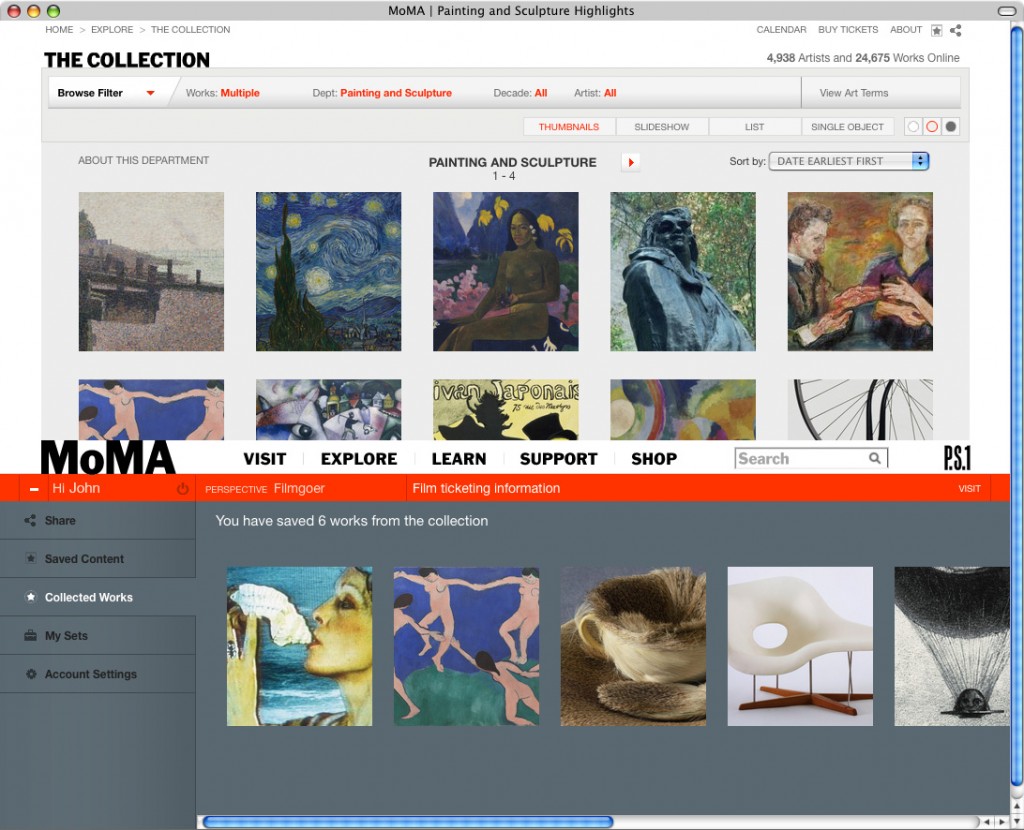
Webpage from the redesigned MoMA.org, with images from the Online Collection
I remember, back when I was in art school, walking into a lecture hall where someone had scrawled on the chalkboard, “The only true artists are amateurs.”
That was the 1970s, when the object was dematerialized and the gallery system, for the avant-moralist, was integrity’s sinkhole. Extremes beget extremes, and after Vietnam, Nixon, and Kent State, a rage against authority of any stripe channeled young artists toward ideological purity and radical form. It was fun while it lasted.
The other day I revisited the exhibition, Compass in Hand: Selections from The Judith Rothschild Foundation Contemporary Drawings Collection, at the Museum of Modern Art, which I reviewed for the current issue of the Brooklyn Rail. The show had left me with such a negative reaction that I began to second-guess myself – which I’d never done before – on the validity of my response. I came away feeling even worse but while I was there, I overheard a couple discussing a wall of drawings by Per Kirkeby, Luc Tuymans, Rosemarie Trockel, H.C. Westermann, and others, solely in terms of what they would fetch at auction.
I’m not sure why this surprised me, perhaps some lingering, willful naïveté about what ultimately matters in a work of art. It’s probably the same reason why I kept looking through the various Flash Points entries on the value of art for one that would discuss it in terms of anything other than price (though, to be fair, this was how Beth Allen framed the question in her original post).
Although the notion that the only true artists are amateurs is flagrantly impertinent, it does strike at the core of the question. It certainly lies beneath the ongoing fascination with outsider art – that the pressure of passion (or obsession or compulsion) must be expressed at all costs.
Incandescent passion – no matter how unpleasant or fatuous – is surely what is drawing such large crowds to the current Francis Bacon retrospective at the Metropolitan Museum, while on the other side of the building, the deliberate avoidance of emotional commitment among the artists of The Pictures Generation succeeds in turning that show into a suffocating bore.
But to return to the Museum of Modern Art, what bothered me about many drawings in Compass in Hand, particularly the more recent work, was their disregard of shared experience in favor of esoteric, often hermetic pursuits. By shared experience I’m not referring to social exchange (indexed by monetary worth) as discussed in the previous Flash Points posts, but to the personal and communal rituals that mark off the progression of our days.
Taking the escalator to the fourth floor, I stopped in front of Picasso’s Night Fishing at Antibes from 1939, which hangs at the entrance to the permanent collection. Never my favorite Picasso due to its cartoonish over-stylization, I was nonetheless struck by the tension between the universality of its theme – the eternal search for food from the sea – and the eccentricity of its formal invention; the former provides intelligibility while the latter does all it can to subvert it.
This is the gist of modernism – distrust of appearances, truth revealed through distortion, exploration of the medium as its own reality: qualities that existed in the work of the School of Paris, including the amateur painter Henri Rousseau, before anyone put a price tag on it.
Money may be a shared commodity but it fractures perception; not only is it the most unreliable historical indicator of aesthetic value, but when art is rendered into a trophy and displayed as such, its role as a piece of communal experience, owned by all, is diminished. Nowhere is this more graphically demonstrated than in MoMA’s 2004 expansion and reinstallation, where masterpieces of the 20th Century hang like caribou heads in barnlike, one-size-fits-all galleries – not connecting, not conversing, not communicating anything beyond their spot in a predetermined timeline, as independent of one another as the thumbnails on the museum’s website.
It’s a sorry state, but not the end of the game. Artists will continue to find ways to inoculate themselves against the confusion of price and value, the conversation will proceed apace, and the golden calves and diamond skulls of our recent, benighted past will inevitably fade into obsolescence.



